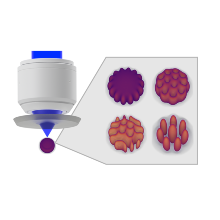Fine magnetic particles suspended in a fluid – so called classical ferrofluids – can self-organize in a variety of shapes ranging from droplet- (“bubble”) through honeycomb- (“foam”) to labyrinth- (“stripe”) patterns (see Science 267, 476 (1995) and this video). Experimentally, ultracold dipolar quantum gases have been shown to host quantum droplet patterns, which combined with their superfluid properties eventually lead to the discovery of supersolidity in this quantum system (Phys. Rev. Lett. 122, 130405 (2019), Phys. Rev. X 9, 011051 (2019) and Phys. Rev. X 9, 021012 (2019)).
So far, the honeycomb and labyrinth shapes known from the classical system have not been observed in dipolar quantum gases. Embedded in the field of complex systems however, dipolar quantum gases show similarities to quantum systems ranging from superconductors to neutron stars for which these patterns have been observed or predicted. In our recent theoretical study, we show that honeycomb and labyrinthine patterns are indeed possible phases of matter in dipolar quantum gases and describe that they realize a new type of supersolid and a superglass, respectively.
In a new project supported by the Vector Stiftung, we investigate the possibilities of superfluid flow through crystalline honeycomb or amorphous labyrinthine structures in dipolar quantum gases and study their similarities to related complex systems. Visit the website of our project "Dipolar Quantum Gases" to learn more about our dipolar quantum gases lab.


